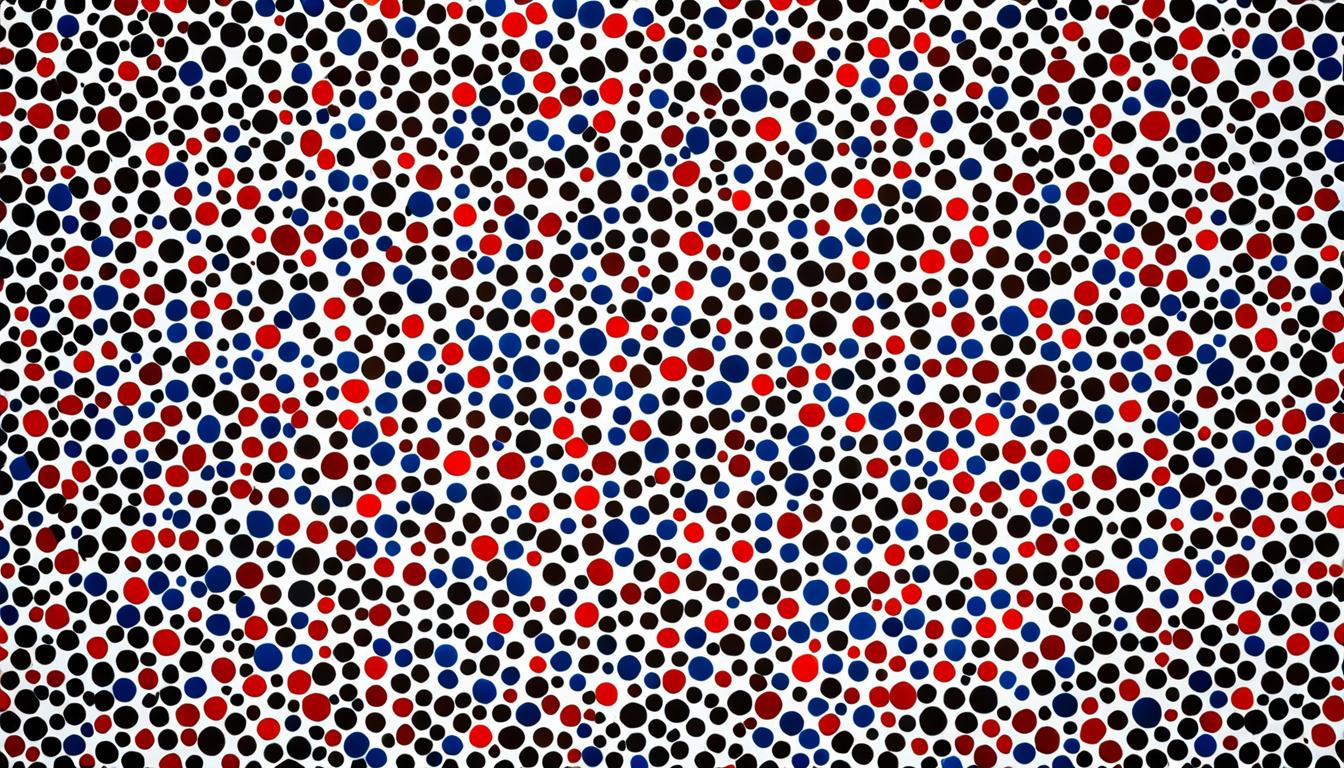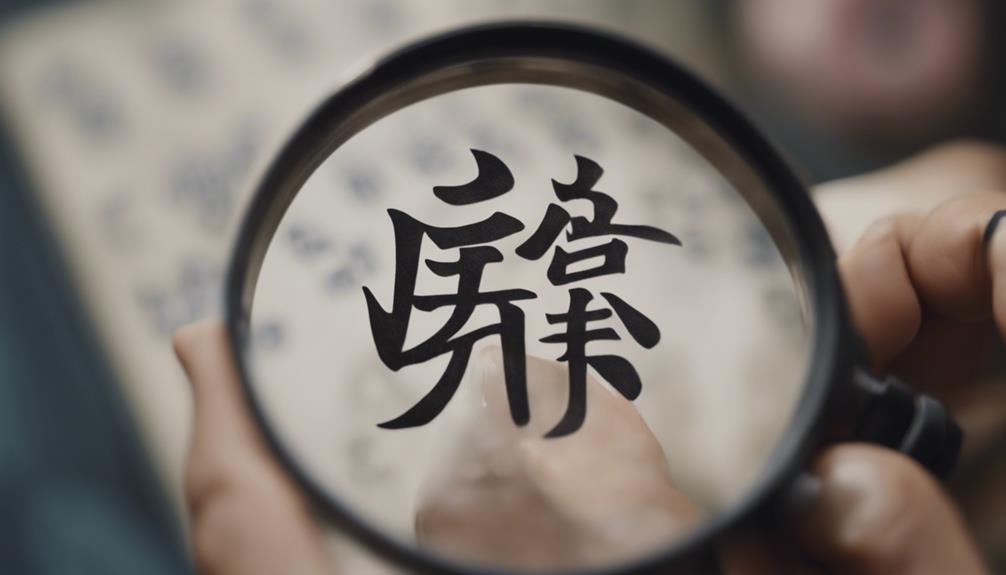Ever hear about how **dots** can change the whole game in art and design? These tiny marks have been around forever, from old-timey symbols to today’s cool graphics, making a big splash in how we see things.
Whether you’re admiring a masterpiece in a museum or exploring the intricate details of a graphic design, the presence of dots can evoke emotions, convey messages, and ignite the imagination.
Key Takeaways:
- Dots symbolize unity, connection, and visual impact in art and design.
- The term “polka dot” originated in the 1850s and gained popularity throughout the 20th century.
- Pointillism, a technique using tiny dots, creates vibrant and luminous effects in paintings.
- Dots are deeply embedded in the cultural richness of Indigenous Australian art, particularly in dot painting.
- Contemporary artists use dots symbolically to explore themes of infinity, repetition, and the complexities of the human experience.
The Significance of Dots in Visual Communication
Dots are more than just simple geometric shapes; they serve as the foundational element in visual communication, encompassing a wealth of meaning and symbolism. From ancient cave paintings to modern graphic design, dots hold great significance in conveying messages and creating visual impact.
Visual communication relies on the power of dots to represent unity and connection. Just as dots serve as building blocks, connecting to form intricate patterns and images, they also connect ideas, concepts, and people. Dots bring elements together, creating a sense of harmony and cohesion.
Moreover, dots embody the essence of the visual message. Their small size and simplicity allow them to capture the viewer’s attention, like tiny sparks that ignite curiosity and engagement. Whether used to denote emphasis, guide the eye, or add visual interest, dots are versatile tools in the language of visual communication.
Ancient cultures understood the power of dots in visual storytelling. Cave paintings dating back thousands of years feature dots as part of intricate narratives, depicting important events, rituals, and beliefs. These ancient artisans recognized the visual potency of dots, using them to create memorable and impactful compositions.
In contemporary graphic design, dots continue to play a pivotal role. Their presence evokes a sense of modernity, simplicity, and sophistication. By strategically placing dots, designers can create dynamic compositions that draw the viewer’s eye and communicate complex ideas with clarity.
“Dots are the atoms of the visual world. They have the power to unite, engage, and captivate viewers, leaving a lasting impression on the minds of those who encounter them.” – Graphic Designer Jane Anderson
The use of dots in logo design is another testament to their significance in visual communication. Logos, being the face of a brand, often utilize dots to convey trust, balance, and interconnectedness. Famous examples include the iconic multi-colored dots of the Google logo, representing a harmonious connection of ideas and resources.
Visual communication is a language where dots serve as essential characters, conveying meaning beyond words. They are visual cues that resonate with viewers, generating emotions and associations that transcend language barriers. Dots have the power to create a universal visual language, which enriches our understanding and fosters connection in a visually driven world.

Connecting the Dots: The Impact of Dots in Advertising
In the advertising world, dots are strategically employed to capture attention, convey brand messages, and leave a memorable impression. Advertisers understand that dots, when used effectively, can create visual interest and intrigue. They act as visual hooks that draw the viewer in, urging them to explore further.
In print advertisements, dots are often used as design elements, adding rhythm, balance, and energy to the layout. Dots can create eye-catching patterns, leading the viewer’s gaze across the page and guiding their attention to key information or product features.
In digital advertising, dots can be animated or interactive, providing an engaging user experience. They can be used to map out user journeys, depict connections between products or ideas, or highlight key points. Dots serve as visual indicators, guiding users through the digital landscape and enhancing the overall user experience.
Whether in traditional print or digital formats, dots are versatile tools in the advertising world, enabling brands to convey their message effectively and captivate their target audience.
Applications of Dots in Visual Communication
| Application | Example |
|---|---|
| Logo Design | Google’s multi-colored dots |
| Typography | Using dots to create patterns in text |
| Infographics | Using dots to represent data points |
| Website Design | Creating dot-based animations or interactive elements |
| Print Advertising | Using dots to create eye-catching patterns in magazine ads |
The History of Polka Dots
In the world of patterns, few are as distinctive and playful as polka dots. What is the history behind these delightful dots? Let’s take a journey back in time to discover the origins and evolution of polka dots.
The term “polka dot” first appeared in the 1850s, describing a pattern of round dots. It is believed that the name originated from the popular dance of the time, the polka, which was known for its lively and upbeat movements. The polka dot pattern embodies the energy and spirit of this dance, adding a touch of whimsy to any design.
During the 20th century, polka dots gained popularity and became associated with femininity and fashion. Iconic figures like Marilyn Monroe and Audrey Hepburn embraced the polka dot trend, solidifying its status as a timeless pattern. Polka dots have adorned clothing, accessories, and even home decor, adding a dash of fun to everyday life.
Polka dots have transcended fashion and made their way into art, with prominent artists incorporating them into their work. The repetition and playfulness of polka dots create visual interest and evoke a sense of joy. From paintings to sculptures, polka dots have become a symbol of individuality and self-expression.
“Polka dots are a celebration of life, a nod to the simple pleasures that bring us happiness.” – Artist
Today, polka dots continue to captivate the imagination of designers and creators. They can be found in fashion runways, interior design, and even digital media. The versatility and timeless appeal of polka dots ensure their enduring presence in the world of art and design.
So, the next time you spot polka dots, remember their vibrant history and the joy they bring. Embrace the whimsy and playfulness they represent, and let your imagination run wild with the possibilities of this timeless pattern.
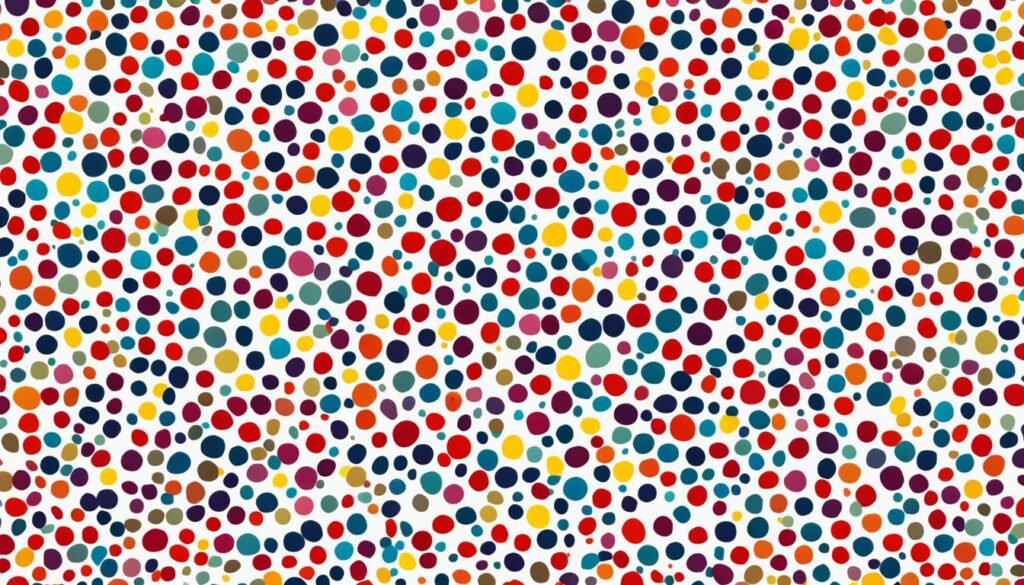
The Enduring Popularity of Polka Dots
Polka dots have remained a beloved pattern throughout the years, enchanting people with their charm and vibrancy. Their timeless appeal can be attributed to their ability to transcend trends and evoke a sense of nostalgia.
- Polka dots bring a sense of playfulness and whimsy to any design.
- They add a touch of retro glamour to fashion and interior decor.
- Their repetitive pattern creates visual interest and draws attention.
- Polka dots symbolize joy, celebration, and the simple pleasures of life.
Whether it’s a polka dot dress, a dotted wallpaper, or a playful art piece, polka dots have a way of brightening up any space and putting a smile on your face. So, embrace the timeless charm of polka dots and let them add a splash of fun to your everyday life.
Pointillism: Dots as an Artistic Technique
Pointillism, an artistic technique pioneered by Georges Seurat, harnesses the power of tiny dots to create breathtaking images. This technique beautifully blends colors optically, resulting in a vibrant and luminous effect.
Pointillism is a testament to the artistic potential of dots. With careful placement and a masterful eye, artists can build entire compositions by layering countless dots of varying colors. This meticulous process demands precision and patience, as each dot contributes to the overall harmony and visual impact of the artwork.
The technique of pointillism allows artists to explore the interplay between colors and light. By strategically placing dots side by side, a seemingly infinite range of hues and shades can be achieved through the viewer’s optical perception. When observed from a distance, the individual dots merge and blend, transforming into a rich tapestry of color.

“Pointillism is a bridge between science and art,” said Georges Seurat. “It enables us to represent light more accurately, using only elementary colors and tiny dots.”
This unique technique gives artists the ability to create depth and texture using only dots, crafting intricate details and nuanced tonality in their artworks. The juxtaposition of contrasting colors through pointillism enhances the sense of dimension and adds a captivating visual dynamic to the composition.
Pointillism emerged as a response to the increasing interest in color theories and the scientific understanding of how the human eye perceives color. Seurat and other artists of the time believed that this technique captured the essence of light in a more accurate manner, allowing for a more faithful representation of the visual world.
Notable artists who have embraced pointillism include Georges Seurat himself, Paul Signac, and Henri-Edmond Cross, among others. Their works showcase the mastery of this technique and its ability to yield stunning and evocative paintings.
Pointillism exemplifies the transformative power of dots in art, demonstrating that even the smallest elements can come together to create something extraordinary. The meticulous placement of dots, resulting in an interplay of colors and an illusion of depth, makes pointillism a truly dynamic and captivating artistic technique.
Dot Symbolism in Indigenous Australian Art
Indigenous Australian art encompasses a rich and diverse range of artistic practices, each with its own unique story to tell. One particular technique that holds deep significance is dot painting. In Indigenous culture, each dot represents a connection to the Dreamtime, ancestral stories, and the land.
The dots used in these paintings are not merely decorative; they carry profound meaning and messages passed down through generations. The process of creating dot paintings is a spiritual experience that allows artists to communicate their cultural knowledge and preserve Indigenous traditions.
Dot painting is a visual representation of the Dreamtime, which encompasses the creation stories and spiritual beliefs of the Indigenous people. Each dot symbolizes a specific element of the Dreamtime, whether it be a spiritual being, a sacred place, or a significant event. The careful placement of each dot creates a visual narrative that tells the story of the artist’s connection to the land and their ancestors.
By engaging with dot paintings, viewers have the opportunity to immerse themselves in Aboriginal culture and gain a deeper understanding of the significance of the land and the spiritual beliefs of Indigenous Australians. These artworks serve as a powerful reminder of the enduring connection between the Indigenous people and their ancestral lands.
“Dot paintings allow us to share our cultural knowledge and pass it down to future generations. Each dot carries the weight of our history and our connection to the land.”
Dot painting has become a widely recognized and valued art form both in Australia and around the world. Its unique aesthetic, rich symbolism, and cultural significance make it a valuable addition to any art collection. The intricate patterns created by the dots and the vibrant colors used in these paintings evoke a sense of spirituality, beauty, and respect for the natural world.

The Symbolism of Dots in Contemporary Art
Contemporary art is a powerful platform for exploring symbolism and pushing creative boundaries. Artists like Yayoi Kusama and Roy Lichtenstein have embraced dots as a symbol in their work, elevating them from mere design elements to carriers of deeper meaning.

In the realm of contemporary art, dots can take on various symbolic interpretations. They serve as visual metaphors for concepts such as infinity, repetition, and the complexities of the human experience. When skillfully used, dots invite viewers to contemplate the intricate connections between the individual, society, and the cosmos.
Yayoi Kusama, a renowned Japanese artist, is famous for her immersive art installations filled with polka dots. These dots, often rendered in bold colors, symbolize her personal struggles with mental health and the overwhelming sensations she experiences. Through her repetitive dot patterns, Kusama invites viewers into a meditative and introspective journey.
Roy Lichtenstein, on the other hand, uses dots to pay homage to popular culture and challenge artistic conventions. His signature technique, known as Ben-Day dots, involves meticulously painting small dots to mimic the printing techniques used in comic books and commercial imagery. Lichtenstein’s dots play with the notion of high and low art and blur the boundaries between mass-produced images and fine art.
“Dots are the atoms of art.” – Yayoi Kusama
The symbolism of dots in contemporary art extends beyond individual artists. They represent the interconnectedness of ideas, emotions, and narratives in a rapidly changing world. Dots can be seen as markers of interconnectedness, reminding us that every action has a ripple effect and that seemingly small dots can contribute to a larger collective impact.
The Intersection of Tradition and Innovation
Incorporating dots into contemporary art is a way of bridging the gap between tradition and innovation. By connecting to ancient symbolism and incorporating it into modern artistic expression, artists invite a dialogue between the past and the present.
Contemporary artists continually push the boundaries of how dots can be used in their work. They experiment with scale, color, texture, and arrangement to create visually striking compositions that captivate viewers and encourage them to delve deeper into the layers of meaning embedded within the dots.
Exploring Dot Symbolism
Contemporary art opens up a realm of exploration and interpretation when it comes to dot symbolism. Artists and audiences alike are invited to question the significance of these seemingly simple elements and find personal connections to their work.
- The infinite possibilities of dots: Dots can symbolize limitless potential and the vastness of the human imagination.
- The power of repetition: By repeating dots, artists can convey the cyclical nature of life, the rhythmic patterns of existence, and the transformative power of consistency.
- The complexity within simplicity: Though dots may appear simple at first glance, they can represent the intricacies of human emotions, relationships, and the multifaceted nature of identity.
Contemporary art challenges us to dive beneath the surface and explore the layers of meaning encoded within the humble dot. By engaging with art that incorporates dot symbolism, we can expand our understanding of the world and our place within it.
The Cultural Significance of Aboriginal Art
Aboriginal art is deeply rooted in the rich heritage of the Indigenous people of Australia. It encompasses a wide range of techniques, including dot painting, bark painting, and rock art. Aboriginal art carries stories, traditions, and history, making it a treasure trove of cultural richness.
Dot Painting: Preserving and Sharing Cultural Knowledge
One of the most iconic techniques in Aboriginal art is dot painting. Each dot represents a connection to the Dreamtime, ancestral stories, and the land. Artists use vibrant colors, intricate patterns, and precise dot placement to depict their cultural heritage.
Dot painting is not just a form of artistic expression; it serves as a way of preserving and sharing cultural knowledge. Through their art, Indigenous artists pass down stories, traditions, and history to future generations, ensuring the continuation of their rich heritage.
Bark Painting: Honoring Ancestral Stories
Another notable form of Aboriginal art is bark painting, where artists create intricate designs on sheets of bark. These paintings often depict ancestral stories, creation myths, and connections to the natural world.
Bark painting is deeply rooted in cultural traditions, as the preparation of the bark and the process of painting are passed down through generations. The art form reflects the close relationship between Indigenous Australians and the land, showcasing their deep respect and spiritual connection to nature.
Rock Art: A Glimpse into Ancient Aboriginal Culture
Rock art represents an incredible historical record of Aboriginal culture, with some sites dating back tens of thousands of years. These artworks can be found throughout Australia, depicting various aspects of Aboriginal life, including hunting scenes, spiritual rituals, and Dreamtime stories.
The rock art serves as a link to the past, providing insights into the ancient Aboriginal way of life and their deep connection to the land. It showcases the enduring legacy of Aboriginal culture and its ability to transcend time.

Aboriginal art is more than just a visual representation; it is a powerful medium for storytelling, cultural preservation, and honoring ancestral traditions. Through their art, Indigenous artists continue to celebrate their identity, share their stories, and enrich the world with the cultural richness of Aboriginal art.
The Aesthetic Appeal of Aboriginal Art
Aboriginal art is renowned for its unique aesthetic, characterized by vibrant color palettes, intricate patterns, and meaningful symbolism. The art form encompasses a wide range of styles, but one aspect that stands out is the use of dot paintings. These mesmerizing creations, often created with natural pigments, capture the essence of Indigenous Australian culture and spirituality.
Aboriginal art embraces nature and spirituality, creating a visual language that resonates with viewers worldwide.
Dot paintings employ the technique of pointillism, where tiny dots are meticulously applied to the canvas or other surfaces. This meticulous attention to detail creates a mesmerizing effect that draws the viewer in, inviting them to explore the intricate patterns and stories embedded within.
The Power of Dots
The dot paintings showcase the mastery of Indigenous Australian artists in capturing the essence of their culture. Each dot represents a specific element, such as sacred sites, ancestral beings, or ceremonial practices. The arrangement and color combinations of the dots convey complex narratives and deep spiritual connections.
Furthermore, the use of vibrant earthy tones reflects the close relationship between Indigenous Australians and the land. The rich ochres, yellows, and reds evoke a sense of connection to the natural world and pay homage to the ancient traditions that have shaped their cultural identity.
When incorporated into interior design, Aboriginal art adds depth, texture, and a distinct, modern touch to any space. The dot paintings can transform a room, creating a visually stunning focal point that sparks conversation and brings a sense of cultural appreciation.
Aboriginal art has gained worldwide recognition, with renowned galleries and collectors valuing the unique aesthetic it offers. Whether displayed on gallery walls or showcased in private collections, these artworks continue to captivate art enthusiasts and serve as a testament to Indigenous Australians’ artistic heritage.
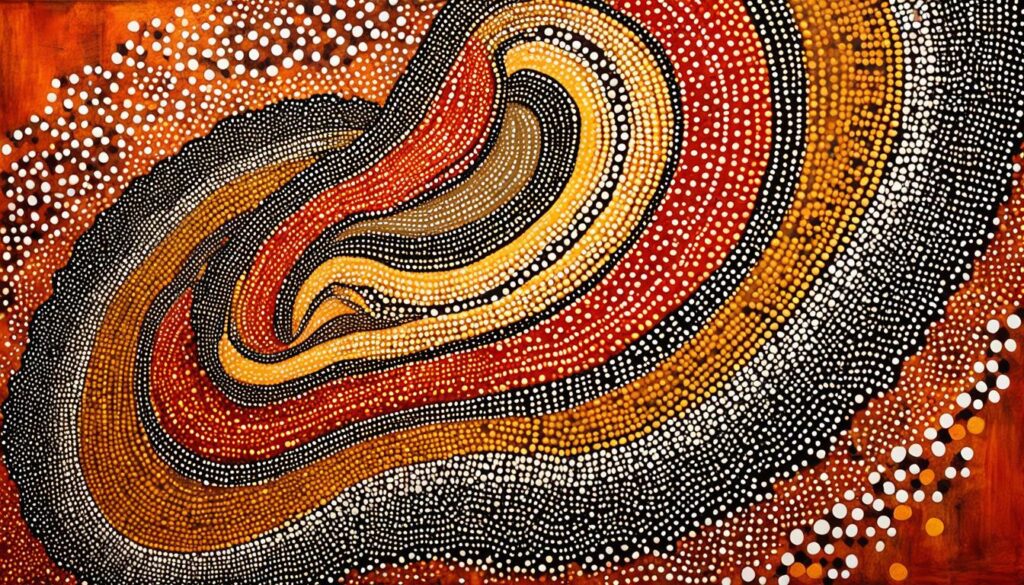
| Key Features of Aboriginal Art | Their Aesthetic Appeal |
|---|---|
| Use of vibrant color palettes | Creates visually stunning effects |
| Intricate patterns and symbols | Adds depth and texture to interior design |
| Meticulous dot paintings | Invokes a sense of cultural appreciation |
| Rich earthy tones | Embodies deep spiritual connections |
| Reflection of Indigenous traditions | Offers a distinct, modern touch |
The Symbolism and Storytelling in Aboriginal Art
Each piece of Aboriginal art is infused with symbolism and storytelling. The symbols, patterns, and colors convey Aboriginal art stories, aspects of the natural world, and cultural lore. Owning Aboriginal art means having a fragment of a story on your wall, a constant source of reflection and discovery.
Aboriginal art is an ancient and powerful form of expression that holds deep meaning and significance for Indigenous communities. Through the intricate use of symbols, artists communicate their spiritual beliefs, ancestral connections, and the stories that have been passed down through generations. Each dot, line, and color choice is intentional and participates in the rich tradition of symbolism in Aboriginal art.
As Clifford Possum Tjapaltjarri, one of the renowned Aboriginal artists, said, “We put all our stories down in symbols, and we tell them through our paintings, so that when we are not here, the stories are still here.”
The dot painting technique, which has become synonymous with Aboriginal art, is not merely a decorative style but a way of communicating cultural knowledge. Each dot represents a specific element of the Dreamtime, the spiritual time of creation in Aboriginal mythology. The placement, color, and size of the dots together form intricate patterns that depict Dreamtime stories, maps of the land, and ceremonial practices.
Moreover, the colors used in Aboriginal art also carry symbolic meanings. For instance, red often represents the earth and the spiritual connection to the land, while yellow signifies the sun and the life-giving energy it provides. White is associated with water, clouds, and the cleansing power of rain.
Acquiring Aboriginal art means bringing a profound storytelling element into your space. Each artwork becomes a visual narrative, inviting viewers to immerse themselves in the cultural context and symbolism behind it. The stories depicted in the artworks connect people to the traditions, histories, and spiritual beliefs of the Indigenous communities.

Furthermore, owning Aboriginal art is a way to support and celebrate Indigenous culture. By appreciating and valuing these artistic expressions, individuals contribute to the preservation of traditions and the economic well-being of the Indigenous communities. Additionally, the presence of Aboriginal art in homes and public spaces fosters cross-cultural understanding and appreciation for the diverse cultural heritage of Australia.
Some common symbols and their meanings in Aboriginal art:
| Symbol | Meaning |
|---|---|
| U-shapes | Human figures, often representing ancestors and important figures in stories |
| Concentric circles | Waterholes, wellsprings, and gathering places |
| Wavy lines | Water flow, rain, or rivers |
| Dots | Depict various elements such as bush tucker (food), tracks, and ceremonial sites |
| Animal tracks | Signify the presence of specific animals or tell stories associated with them |
| Circles | Dreaming sites or sacred places |
Through the symbolism and storytelling present in Aboriginal art, viewers are invited into a world of rich cultural significance and intergenerational wisdom. Each artwork offers a glimpse into the Dreamtime, the natural world, and the stories that have shaped and continue to shape Indigenous communities. Immersing oneself in Aboriginal art is not only an aesthetic experience but also an opportunity to embrace and honor the cultural heritage of Australia’s First Nations people.
Supporting Indigenous Communities through Art
When you purchase authentic Aboriginal art, you are not only acquiring a beautiful piece for your collection but also making a significant impact on Indigenous communities. By supporting Indigenous artists and their work, you contribute to the preservation of traditional art forms and play a vital role in the economic well-being of these communities.
Indigenous communities hold deep cultural knowledge and artistic traditions that have been passed down through generations. The creation and sale of Aboriginal art provide a platform for artists to share their stories, maintain cultural identity, and strengthen their communities.
“Aboriginal art is a living expression of spirituality, connection to the land, and cultural heritage. Purchasing authentic artwork allows us to support Indigenous artists and their communities, fostering a sense of pride, revitalization, and celebration of Indigenous culture.” – Sarah Thompson, Art Curator
Investing in Indigenous art goes beyond acquiring a beautiful piece; it is an opportunity to become part of a movement that supports and celebrates Indigenous culture. Your support helps ensure that traditional art forms continue to thrive, empowering artists and enabling them to pass down their knowledge to future generations. By acknowledging and appreciating the value of Indigenous art, you contribute to a more inclusive and diverse artistic landscape.
Benefits of Supporting Indigenous Communities through Art
When you support Indigenous communities through art, you contribute to:
- The preservation of traditional art forms
- The economic well-being of Indigenous artists and their communities
- The perpetuation of cultural heritage and knowledge
- The empowerment of Indigenous artists
- A more inclusive and diverse artistic landscape
| Ways to Support | Impact |
|---|---|
| Purchasing Aboriginal artwork directly from Indigenous artists or reputable galleries | Ensures artists receive fair compensation for their work and supports their livelihoods |
| Attending Indigenous art exhibitions and events | Raises awareness of Indigenous art and culture, promoting appreciation and understanding |
| Sharing Indigenous art with others | Promotes cultural exchange and widens the audience for Indigenous artists |
| Engaging in cultural learning experiences | Deepens understanding of Indigenous art, its significance, and the stories it tells |
By actively engaging with Aboriginal art and supporting Indigenous communities, you create opportunities for cultural exchange, bridge gaps in understanding, and contribute to a more inclusive society. It is a chance to celebrate the richness and diversity of Indigenous cultures while making a positive and meaningful impact.
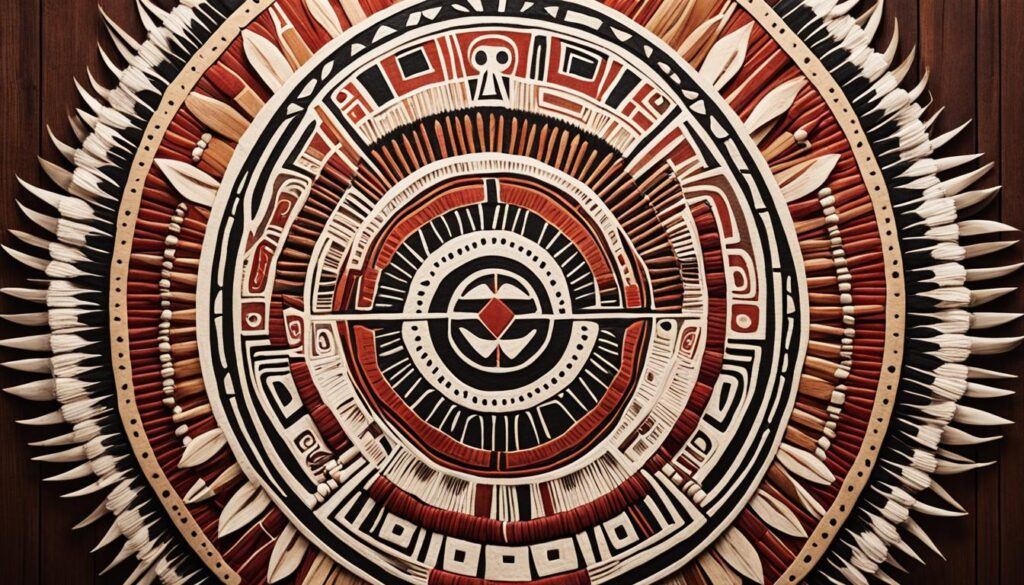
Aboriginal Art as a Spiritual Connection
Many people feel a deep spiritual connection to Aboriginal art. The art often represents the strong spiritual beliefs and connection to the land held by Indigenous Australians. Having Aboriginal art in your home can bring a sense of peace, grounding, and a connection to the natural world.
This spiritual connection is rooted in the Indigenous Australian culture, where art is seen as a medium to convey stories, traditions, and a deep appreciation for the interconnectedness of all living things. From dot paintings to rock art, Aboriginal art reflects the spiritual essence of the land and its importance in the lives of its people.
Aboriginal artists use dots to represent various aspects of their spirituality. Each dot carries significance and meaning, forming intricate patterns that reveal the artist’s connection to the Dreamtime, the spiritual realm of creation and ancestral beings. These dots symbolize the spiritual energy that flows through the land, connecting all living beings and the natural world.
When you bring Aboriginal art into your home, you invite this spiritual connection to enter your space. The art serves as a visual reminder of the sacredness of the land and the importance of respecting and preserving our natural environment. It can create a serene atmosphere, grounding you and offering a sense of harmony and balance.
The use of dots in Aboriginal art also serves as a reminder of our own spiritual connection. It prompts us to reflect on our place in the world and to nurture our relationship with nature and the spiritual essence that permeates all things. By incorporating Aboriginal art into your surroundings, you invite a deeper understanding of our spiritual interconnectedness and a greater appreciation for the beauty and wisdom of Indigenous Australian culture.
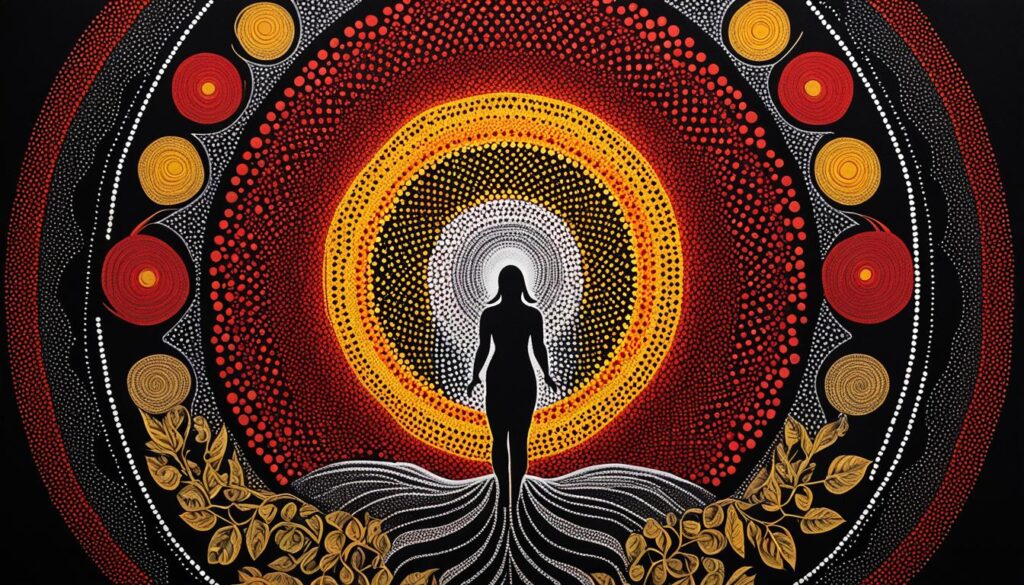
Conclusion
The profound symbolism of dots in art and design is undeniable. From their role in visual communication to their interpretation in various artistic techniques, dots carry meaning, storytelling, and a sense of cultural identity. Whether seen in ancient cave paintings, contemporary art forms, or Aboriginal artwork, dots are a powerful element that transcends time and cultural boundaries.
The significance of dots as a visual language cannot be overstated. They form the foundation of visual communication, representing unity and connection. Dots invite us to explore the depth and richness of human expression, inviting contemplation of the complexities of life and the world around us.
By embracing dots in art and design, we uncover a world of symbolism that reflects our shared history, individual experiences, and the diversity of human culture. From the bold brushstrokes of pointillism to the intricate dot paintings of Indigenous Australian art, dots leave a lasting impression and ignite our curiosity.
Let us celebrate the beauty and symbolism of dots, and recognize their ability to convey meaning, tell stories, and create a sense of cultural identity. Through the exploration of dots in art and design, we can discover new perspectives, connect with others, and deepen our appreciation for the power of human expression.
FAQ
What is the significance of dots in visual communication?
How did polka dots become popular?
What is pointillism?
What is the significance of dots in Indigenous Australian art?
How do contemporary artists use dots as symbolism?
What is the cultural significance of Aboriginal art?
How does Aboriginal art add aesthetic appeal to interior design?
What does each piece of Aboriginal art symbolize?
How does purchasing Aboriginal art support Indigenous communities?
Why do many people feel a spiritual connection to Aboriginal art?
What is the significance of dots in art and design?
– What is the Symbolism Behind Dots in Art and Design?
In art and design, dots can hold various meanings and purposes. They can symbolize the concept of connection and unity, serving as a representation of wholeness and the interconnectedness of all things. Dots can also be used to create patterns, add texture, or convey a sense of movement within a piece. The meaning of double rainbows in art and design lies in its representation of hope, transformation, and good fortune.

